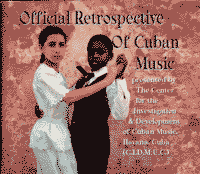
VARIOUS ARTISTS
OFFICIAL RETROSPECTIVE OF CUBAN MUSIC (Tonga Productions)
Dr Olavo Alén Rodriguez has done it again. His last production, FROM AFRO-CUBAN TO SALSA was a book about the development of Cuban music with a CD to demonstrate the different styles. His new production is a 4-CD set: the OFFICIAL RETROSPECTIVE OF CUBAN MUSIC presented by the Center for the Investigation & Development of Cuban Music, Havana.
Drawing on the archives of field recordings at CIDMUC, each CD presents two styles of music. Volume One is Musica Afrocubana y Rumba performed by Omo Trago, Afrocuba de Matanzas, and others. This is the rootsy drum and vocal music used in Santeria rituals.
Volume Two covers the most popular current form of Cuban folk music: the son. Gaining in popularity since the twenties and thirties when the son-montuno was developed, the son continues to influence dance forms today. While the groups presented by Dr Alén Rodriguez are unfamiliar to me, the material is not. Miguel Matamoros' "El beso discreto" is used to demonstrate guaracha with a marimbula added to the line-up (a big version of the African thumb-piano, the marimbula here is used mostly as a percussion instrument, with the player tapping on the sound-box for a great woody effect). Another guaracha performed here, Ñico Saquito's "Menéame la Cuna (Sway my crib)", a song loaded with double entendres, is less well-known. "Sarandonga" which I think was written by Arsenio Rodriguez, is here credited to the singer Aldo del Rio, who recorded it in Pinar del Rio in 1989. The ever-popular "Echale Candela" really turns the heat on, while Ignacio Piñeiro's "Te busqué anoche" is delivered by Son del Mayabeque. The closing track of this CD is "Querida Paloma," a rocking jam by the group La Melodía from Guantánamo who use guitar, tres, electric bass, and a raft of percussion.
Volume Three, Punto Cubano y Cancion, starts with Decimas -- freeform poems of ten lines often improvised with simple tres and percussion accompaniment, guiro, claves, and even machete. The link to medieval Spanish music is most apparent here. There is an ad-libbed cutting contest between two poets, and demonstrations of Afro-Cuban spiritual singing, which however sounds a lot like Western liturgical music to my ears. But then I can "totally" hear the Beatles' "Do you want to know a secret?" in "Amorosa guajira," which Dr Alén Rodriguez describes as "a cancion of urban origin that relates sugarcoated and idealized peasant themes." Could it be that the Fab Four were hip to Trio Matamoros in the early sixties?
This cancion is followed by a very wet "bolero con feeling" by Bola de Nieve, performed by Aldo del Río, accompanying himself on tres (I guess the snowball melted into a stream). I'm not a fan of Nueva Trova, so I will not comment on the Silvío Rodriguez composition performed by Duo Enigma, other than to say if you like the folksy guitar intro on "Stairway to Heaven" you'll love this.
Things perk up with the bolero-son delivered by Estudiantina Matancera; yes it's "Lagrimas Negras," another classic from the legendary Miguel Matamoros. And again the set ends with a rave-up, this time an afro-cancion "Raices Cubanas" performed by the son septet Los Naranjos.
Volume Four, El Danzon y la Musica Tradicional Actual, puts me back on terra firma as far as familiar and enjoyable melodies are concerned. Though the ensembles here are definitely on the warbly side (fans of Portsmouth Sinfonia will dig the slightly out-of-tune violins), the cuts get more & more confident. Track 3, José Urfé's landmark "El Bombin de Barreto," composed in 1910, here quotes "El Manisero." Tracks 2, 4 & 5, played by Charanga Típica Cubana under the direction of González Rubalcaba, are reminiscent of Cachao's lushly orchestrated danzons (on MASTER SESSIONS and similar albums). "El cadete constitucional" quotes, remarkably, "Hooray for the red, white and blue." I wonder if this is a conscious quote or whether they adopted it from Warner Bros cartoons. Track 5, "Para Elizabeth," is clearly based on Beethoven's "Für Elise." And again we get a smoker to close, Grupo Yarey, an electrified group fronted by a saxophone playing the melody, give us "De mi hacia tí."
Though the four albums are inevitably uneven, it is safe to say this compilation is exhaustive, and the serious student or fan will not find a better-laid-out exposition of the many styles of popular Cuban music than this set.

AFRO-CUBAN ALL STARS
DISTINTO, DIFERENTE (World Circuit)
Afro-Cuban All Stars come from the same loose conglomeration of artists that also make up Buena Vista Social Club. Collectively they might be thought of as Los Teletubbies Cubanos, a bunch of big stars now being marketed to the American audience. Afro-Cuban All Stars have the musical advantage (but marketing disadvantage) of not having Ry Cooder on their new album, instead they are under the sure guidance of Juan de Marcos Gonzalez, whose Orchestre Sierra Maestra did so much to reinvigorate the traditional music of Cuba before he was inducted into the Socialists' ranks.
The new Afro-Cuban All Stars album DISTINTO, DIFERENTE is neither. In concert in 1997 at Zellerbach Auditorium, Berkeley, they were much looser and more interesting than on their first album, but the first half of the new album sounds like the left-over tracks from the first session. It starts out slow and gets slower. There are a few noteworthy moments though and if, like me, you'll buy an album for one or two outstanding cuts then you'll want this. A cover of Arsenio Rodriguez's "Tumba Palo Cocuye" really cooks, though the piano is no match for the original by Lili Martinez, but of course the sound is a lot fuller. I don't know who's on the new Afro-Cuban album, I only heard a pre-release rough mix, but it should be out by the time you read this. The first album had the great Ruben Gonzalez on piano, but on tour he was replaced by the equally august Guillermo Rubalcaba, father of the celebrated jazz pianist Gonzalo.
After a rousing medley of some Nino Rivera songs, the old folks go on the nod for the mid-part of the album. Their interpretations of "Al vaiven de mi carreta," etc, are fine, it just has no life, no spark. They really need some young blood to get in there and throw out a smoking trumpet solo, or a singer who has not passed their prime. Francisco Repilado's "Huellas del pasado" has a promising jam (Compay Segundo who first recorded it may even be on here), and then as a total surprise, track nine "Warariansa" is a conga, the type of percussion jam you hear in the streets of Santiago and unlike anything else the band does. But just to be sure everyone is comatose at the end a really sleepy danzon rounds out the set.
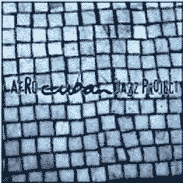
AFRO-CUBAN JAZZ PROJECT
Pancho Amat, the great tres player (who toured in one of the incarnations of Cubanismo), appears on an outstanding new release of contemporary Cuban music. AFRO-CUBAN JAZZ PROJECT is so understated, both as the name for a group and in the presentation (it has the worst, most illegible packaging I can recall in some time) that you might miss it. There are no really big names here, which in some ways is refreshing, but a lot of dedicated Cuban jazz musicians going full tilt on different musical forms, mostly ending up in a descarga or free-form jam. Well, actually, the musicians are well-known to real aficionados: artists like Tata Güines the conguero, and flautist Maraca, in addition to Pancho Amat on tres and a token member of Los Teletubbies Cubanos: Barbarito Torres, the lautist who played on all of the Teletubby albums, as well as anchoring his own brilliant opus, HAVANA CAFE.
Here are many wonderful compositions in all styles of Cuban music, but since I have been ardently studying Cuban music for the last decade I have heard many of these compositions before, quite a few of them by several different artists. Still it's heartening to have musical touchstones: when you know the pianist is about to quote "Holiday for Strings" or the trumpeter riffs on "Theme from a Summer Place" or, inevitably, "El Manisero," but it's also gratifying to find a group that moves beyond the clichés into uncharted territory.
The feeling on this session is akin to both the recent Cubanismo outings and the descargas led by Cachao, Miguelito Cuni and Felix Chappotin in the fifties. The material covered includes a fine danzon, and a lot of charanga, a couple of ballads, a bolero, and a slamming conga to end. The sound is full, particularly the bass and bata drums, and everyone on the session acquits themselves with honours.
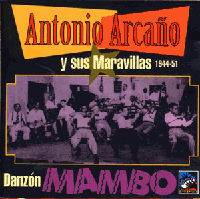
ANTONIO ARCAÑO Y SUS MARAVILLAS
DANZON MAMBO 1944-51 (Tumbao TCD 029 1993)
The popular Mexican film DANZON sparked a renewed interest in that version of the Mambo, through its great soundtrack album. In addition to the film's soundtrack, there is a great Danzón collection by a superb charanga led by Antonio Arcaño that featured the López brothers, pianist Jesus, Orestes on cello, and Israel the bassist, also known as the legendary Cachao, inventor of the rumba. Flautist Arcaño's 14-piece orchestra had a weekly radio broadcast during the 1940s, and constantly sought new material to perform. As most of them had conservatory training, they often reworked light classical pieces. It is a delight to hear snatches of Grieg, Dvorak, Mussorgsky, Rachmaninoff, and Gershwin given the Danzón treatment. (The latter is ever popular in Cuba, where he is often referred to as Gershwing!) So prepare to spot the New World Symphony or "Rapsodia en Azul". The new dance was quickly popularized by Perez Prado, but it was Arcaño's inspired flute solos that made it so memorable. We're talking class here: pizzicato violins, stop-action percussion and escalating key changes that must remind some listeners of the Carl Stalling style. One can see where Stalling -- brilliant composer of the Warner Brothers' Looney Tunes cartoon music -- got some of his inspiration. This is another strong entry in the Tumbao Cuban Classics catalogue.
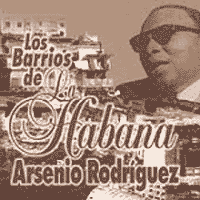
ARSENIO RODRIGUEZ
LOS BARRIOS DE LA HABANA (Orfeon CDL 16400)
Do I really need a nineteenth Arsenio Rodriguez album in my collection? Perhaps not. These dozen tracks were compiled from 78s recorded in Havana in the late 1940s. The majority of them reappeared on two CDs from Tumbao in 1993 and 1994, MONTUNEANDO and DUNDUNBANZA. I picked it up because I don't have the opening cut, or the version of "Amor Sagrado" that's also on here. "La Vida es un sueño" is a different take, with gratuitous cocktail lounge organ added. The version that opens with toy piano on "Montuneando" has to be the definitive version. Arsenio created the Son Montuno, extending the septet to include piano and more percussion and allowing the musicians to stretch out. This free-form jam led ultimately to salsa, so Arsenio occupies a very important place in the history of Latin music. He surrounded himself with superb musicians, like Felix Chappotin, Miguelito Cuni and Luis Martinez Griñan, a.k.a. Lily. His music has been covered by every Latin artist from Larry Harlow and the Fania All Stars to Sierra Maestra. He ruled quietly with his tres, only stepping to the fore during his solos, otherwise the vocalists are prominent, the horn arrangements very smooth -- the musical equivalent of a tall cool glass of Cuba Libre. There's a weird freeform jazz thing called "De un manera espantosa" including a quote from "Rhapsody in Blue," but it has poor acoustics. Only completists need this release, but you should have the Tumbao CDs.
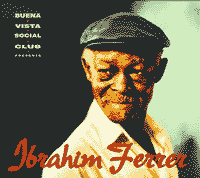
BUENA VISTA SOCIAL CLUB PRESENTS
IBRAHIM FERRER (World Circuit)
World Circuit responded to the incredible success of Buena Vista Social Club by releasing a second studio album: BUENA VISTA SOCIAL CLUB PRESENTS IBRAHIM FERRER. This is more of the same for folks who ate up the first helping. For the most part the songs are slower numbers straight out of the classic canon, from Arsenio Rodriguez's ground-breaking "Bruca Manigua" to Beny Moré's lovely lingering ballad "Como Fué". Buena Vista fans won't be disappointed but I think it'll put a lot of new listeners to sleep: still that may be the soporific effect required by the audience for this. A late-night-unwinding kind of sound. It's funny how the baby boomers have become their parents: getting into Mancini and lounge music and now acquiring the "sophisticated" taste for boleros and son montuno that were popular after the Second World War along with the rumba and chacha crazes.

CACHAO
MASTER SESSIONS VOLUME 1 (Epic EK 64320)
That big bass sound you hear in classic Mambo and Rumba recordings owes it all to Israel López, called Cachao, father of the acoustic or contrabass. This homage is not a bunch of oldsters reliving past glories but rather a survey of hot latin sounds, from the exquisite danza, "Finally I saw you," that opens the set, through classic son, guajira and rumba numbers, to screaming descargas, or jam sessions. "Actor" Andy Garcia put it together for a movie, COMO SU RITMO NO HAY DOS, but the band, with names like Chocolate Armenteros on trumpet, Nestor Torres on flute, Francisco Aguabella on congas, and Paquito d'Rivera on reeds, delivers the goods on an exhilarating ride through the Cuban musical landscape.
There's even a volume two that is just as good.
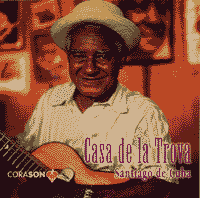
VARIOUS ARTISTS
CASA DE LA TROVA (Corason COCD120)
After finishing their daytime jobs, Cuban musicians head to Santiago's Casa de la Trova, a club that keeps the musical traditions of Cuba alive. On this collection, the groups perform with great feeling and understated energy. The counterpoint, provided by bongos, claves, and maracas, pushes the guitarists to flights of fancy whilst witty and sensual vocals float above it all. As the groups age, they add younger members, who display remarkable finesse, ensuring the survival of this great music. This superb recording documents ten of the regular acts; further solo and group releases are planned.
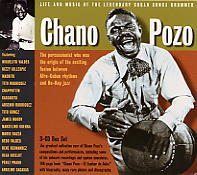
CHANO POZO
EL TAMBOR DE CUBA (Tumbao Cuban Classics 305)
The box set of Chano Pozo, EL TAMBOR DE CUBA, is a big event in Cuban music. I discovered early on that Tumbao is a label to collect and I have learned about the legacy of Cuban music through their excellent reissues. This 3-CD set and booklet completes the picture of the legendary artist that we know was responsible for bringing Cuban rhythms to New York and getting Dizzy Gillespie and others on the path to rhythmic certitude known as Cubop.
While thorough, with over 70 tracks, and musically very exciting (I mean how often do you listen to a whole CD to check out the conga player and really dig it?), there is a small drawback to the production. The producers decided to present the material like a radio documentary so there are tracks of talking as Mario Bauza and Billy Taylor pop in to tell you what you are listening to. Of course this is unnecessary and after one hearing becomes a mild intrusion, but it's easily skipped if you are on top of your CD player. Aside from that, this set is the crucial link between Cuban music and jazz and beautifully describes the "Havana to New York" arc traversed by one remarkable figure. The box includes a book by Jordi Pujol who discusses the history of the music, noting how African drums were illegal in the 1920s and being black meant you were socially ostracised. Pozo was a tough kid gaining a reputation as a street fighter as well as a drummer and dancer. At 20 he fell in love with a 13-year-old girl and serenaded outside her house till she accepted him as her lover. Chano's step-brother was Felix Chappotin who encouraged his unruly side. His best friend was singer Miguelito Valdez, already on his way to fame in a succession of bands (By 1945 he was the top Latin artist in the USA).
Valdez brought Pozo to pianist Anselmo Sacasas to transcribe the melodies Pozo was always humming, which is how "Blen Blen Blen" and his other early hits came about, though Pozo was too dark to be allowed on the bandstand at the fashionable resorts where Orchestre Casino de la Playa played!
Pujol meticulously documents the known facts of Pozo's career: He was only in the USA for two years before he was shot dead by a pot dealer he had crossed, leaving his young bride a widow at 26. It wasn't the first time he had confronted a gunman unarmed. His santeria beliefs usually carried him through such scrapes. But the drama is equally in the music. The end of the story is well known: Through Mario Bauza, Chano was introduced to Dizzy Gillespie. Together they created the first Latin-Jazz Suite and launched a score of imitations.
Pozo himself was followed by Mongo and Patato as the tumba moved to centre stage. The earlier story has well-known names (Arsenio Rodriguez, Tito Rodriguez, Machito, Chappotin), but the music is undeservedly obscure. Some of the 78s sound a little thin but that adds a note of authenticity to the early recordings of Afro-Cuban ritual drumming and chanting. The early recordings of "Ave Maria Morena" and some of Chano's works by Conjunto Azul are incredibly scarce and are presented on CD here for the first time. Great pianists, vocalists and tres players vamp across the stage in these recordings but it's Chano Pozo the conguero who animates the whole show.
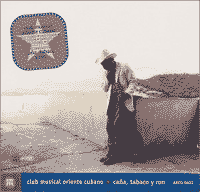
CLUB MUSICAL ORIENTE CUBANO
CAÑA TOBACO Y RON (Secret World ARNR 0602)
One thing that keeps me interested is classic Cuban Son de Oriente, the lilting folk music of Santiago made famous by Miguel Matamoros and his trio in the thirties, then augmented in later bands like Sexteto Machin and Septeto Nacional with trumpet and acoustic bass.
When things are slow on the music front I catch up on Cuba. The new CD from Club Musical Oriente Cubano, CAÑA TOBACO Y RON, is a fine example of traditional acoustic son. The songs are familiar: "Tres Lindas Cubanas," "A Orillas del Cauto," "Mata Siguaraya," "Ay Miguel," etc., but the arrangements are fresh and the playing sharp. It reminded me of Barbarito Torres (without the laoud, however), and even if the repertoire and the name suggest this act is trying to be a latter-day Buena Vista Social Club (or Los Teletubbies Cubanos), it comes across as heartfelt and engaging. Though there's a big cast assembled for this set, the pieces all have the intimacy and lightness of a quintet or sextet. Guzman Plaza on cuatro makes this happen by keeping up a bright and inventive picking style behind each of the singers while the maracas add a romping certitude.
Two of the tracks pay homage to Miguel Matamoros: "Ay Miguel" (made famous by Guillermo Portabales), which quotes three of his tunes in the instrumental break, and Cheo Losada's "A Matamoros, son del Tivoli," which also riffs on "Son de la loma." Then come two tracks plumed by the great sonera Maria Teresa Vera. There's piano on one track, the bolero "Fiebre de Ti," a tribute to Benny More, with a singer in the Pio Leyva mold, and an Erik Satie quote -- the wonderfully atonal Third "Gnossienne," or "Little Knowitall" -- on trumpet, as the hook! This is followed by a classic raucous conga with "Chinese" horns to wake you up. There's even the rock and roll send-up, "A mi me gusta el Cha Cha Cha" by Nico Saquito -- here related in a sweet version with great muted trumpet.
The closing track is an 11-minute workout on Nico Saquito's "En mi Viejo Santiago," which starts out like Bola de Nieve, all tentative and cautious, then halfway through there's a new take with more gusto that goes off like magic, then a third version that adds a big band feeling. It reminded me of Barbarito Torres' band once again and that ain't bad. This is a pleasant harmonious set that doesn't break new territory but is warmly recommended.
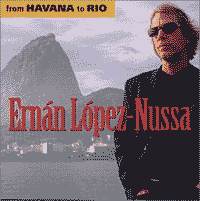
ERNÁN LÓPEZ-NUSSA
FROM HAVANA TO RIO (Velas Records)
A fresh approach is what makes Ernán López-Nussa's FROM HAVANA TO RIO so compelling. He makes a connection between Cuban and Brasilian music with the current of jazz. López-Nussa is a sharp yet subtle pianist and composer. He studied classical music in Havana and was part of the fusion group AfroCuba which often backed Silvio Rodriguez in the 80s (No, I won't say it!). For this session, recorded in Rio de Janeiro, he is accompanied by some hard-hitting Cuban percussionists like Pancho Terry and the great Cuban tumbador Tata Guines, plus guest Brasilian percussionists to push the rhythms out of the expected. They rip through a nineteenth-century contradanza. When it breaks down to the acoustic bass and percussion it's slap up to date.
López-Nussa returns to essay some of the polyrhythmic guajeos that were a trademark of Lili Martinez, pianist and composer with Arsenio Rodriguez. Rodriguez's group is now recognized as the cauldron of salsa. The liner notes compare López-Nussa to Chick Corea but I'd sequence him with Panamanian jazz pianist Danilo Perez. In addition to his own material, López-Nussa performs Mario Bauza's "Mambo Inn" and Ellington's "Sophisticated Lady," the latter as a danzón with a sublime bass flute part played by Brasilian Carlos Malta. Rumba meets samba on a couple of tracks where the cuica and wispy vocals lend that unmistakable Rio air to the mix.

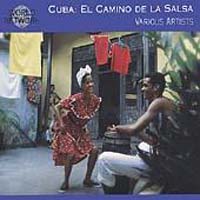
VARIOUS CUBANS
FROM AFROCUBAN MUSIC TO SALSA (Piranha CD)
CUBA: EL CAMINO DE LA SALSA (World Network)
For students of musicology who like some weighty matter to go along with their listening, look no further than Dr Olavo Rodriguez's beautifully presented package: FROM AFROCUBAN MUSIC TO SALSA, a 180-page book and CD from the Piranha label out of Germany. Dr Rodriguez covers the main categories of Cuban music and you can hear fine examples of each of the styles he discusses. The design of the book is relaxed and handsome and a far cry from the frenetic junk that ruins so many CD booklets, rendering them illegible. The musical selections include four Afro-Cuban chants, five examples of the son, including changui and son montuno, four rumbas, five orchestral danzons (some of them a bit creaky), including Ases del Ritmo and two selections from Charanga Tipica de Rubalcaba, and four songs described as El Punto Guajiro.
Musically this compilation stands alongside another fine German release: World Network's CUBA: EL CAMINO DE LA SALSA which also uncovers neglected gems of great Cuban folk music. Septeto Nacional and the rumba group Afrocuba de Matanzas appear on this compilation, but so too do groups I'd never heard of before: the appropriately named Orchestra Sublime and the superb Conjunto Campesino Cuyaguateje who turn in a rollicking acoustic version of the standard "Al vaiven de mi carreta (The rocking of my cart)." So if you are one of those people who only owns one Cuban CD, now it's time to spring for a few more.
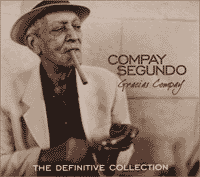
COMPAY SEGUNDO
GRACIAS COMPAY (Warner Latina 60884-2)
This double album celebrates the life and work of Compay Segundo (Francisco Repilado) who, after being rediscovered at an advanced age, worked hard until his death last year. I first heard his classic song "Chan Chan" about twenty years ago and I have many versions of it, so I don't really need the two more on this set. However it is a fitting capper to his career. In 1995, before the Buena Vista Madness, he was in Spain recording at Cinearte Studios in Madrid. Four albums were cut: a trio set; one with an expanded band including three clarinets; duets with notable world music types such as Khaled, as well as other Cuban stars Pio Leyva, Omara Portuondo and, surprisingly, the young and wet heartthrob Silvio Rodriguez. This definitive collection features his own band on the first disc. He began singing on Radio Havana in the 1940s and although his name means "Second vocalist," he was a strong member of various bands, including that of Miguel Matamoros. He wrote some classic Cuban sones, including "Sarandonga," co-written with the first Compère, Lorenzo Hierrezuelo. Repilado did a lot in his 96 years, particularly at the end. This two-CD set is a testament to his greatness as composer and performer. It is a treasure.
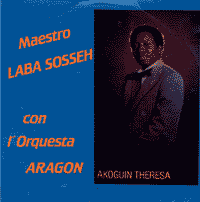
LABA SOSSEH WITH L'ORQUESTA ARAGON
AKOGUIN THERESA (Disco Stock SA 300070)
With the gradual breaking down of the trade embargo with Cuba, Norte Americanos are being treated to decades of the finest music long denied us. Of course New York salseros and rumberos have been growing in popularity among non-Latin audiences since Desi Arnaz's heyday in the fifties, but now some of the pure folk music of the sadly maligned Marxist nation is reaching our shores. Los Muñequitos de Matanzas, the rumba originals from Cuba, took this country by storm on their fall 1992 tour, as did another old-timer, Mario Bauza. Both had stellar musical issues too, but I'm hooked on Laba Sosseh (actually from Ivory Coast) who is backed by Cuba's classic 50-year-old-&-still-going-strong Orquesta Aragon on a collection of old son montuno ballads with great flute and strings like only Aragon can arrange.
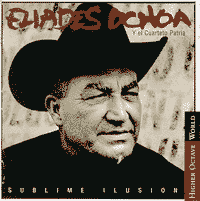
ELIADES OCHOA
SUBLIME ILLUSION (Virgin)
OK so your curiosity overcame your good sense and you went to see Wim Wenders' crappy movie about the Buena Vista Social Club. It's a classic case of cultural slumming by a trendazoid with more money than ideas, that really puts the new Buena Vista Social Club album in a bad light (and bad acoustics too). The endless spiraling camera shots are an indication that Wenders really felt out of his element in this world. But I hope you also caught LAGRIMAS NEGRAS, the far superior film about Cuban music, specifically La Vieja Trova Santiaguera, a great group of old Soneros from the Easternmost tip of the embargoed isle who rehearse then go on a European tour.
But Cubans still top the stack of CDs I want to listen to. Another outing by a member of the notorious BVSC, Eliades Ochoa's SUBLIME ILLUSION, has just been released by Virgin records. He's the broad guy in the cowboy hat who looks like he could be at home in a roadhouse in Texas. Another troubadour from Santiago, his best known work is with Cuarteto Patria, which is legendary in Cuba for having accompanied the great Ñico Saquito on his last album, GOODBYE MR CAT as well as backing the legendary Duo Los Compadres of Francisco Repilado and "Compay Segundo" (another of the BV all-star line-up).
I'm not going to compare the new Elaides Ochoa album to the latest from BVSC, that would be pointless. There are greater forces than mere marketing at work, causing it to fly out the doors far out of proportion to its intrinsic merit. But let me say that you won't be disappointed with Ochoa's "solo" effort. It's a classic of the son and bolero style of which he is one of the living masters.
In the variety of tunes presented here, there are a few tasteful solos by non-Cubans, notoriously Ry Cooder who plays a guitar duet on the classic danzon, "La Comparsa," to end the album. Also Charlie Musselwhite on harmonica and David Hidalgo on guitar embellish & augment "Teje que teje," a romping metaphorical song about an intoxicated girlfriend. For contrast, compare this take to the guaracha version on Cuarteto Patria's A UNA COQUETA which came out in 1993 on the Corason label. Another comparison is possible between the title track and the version on Barbareito Torres' recent HAVANA CAFE. Torres' effort is my favorite album of the year so far, so I'm not going to comment further, but it's interesting to see the Socialites spreading the gospel of son and covering many of the same songs as their material gains wider acceptance in the Western market.